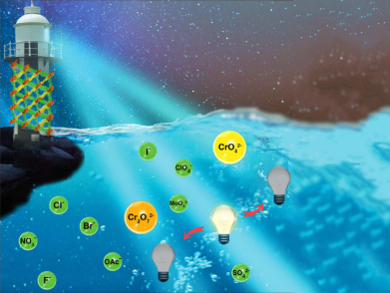The detection of hexavalent chromium in the environment is important due to the acute toxicity of CrVI. Exposure can lead to damage of the respiratory tract and an increased risk of cancer. Luminescent metal-organic frameworks (LMOFs) have quick response times and excellent sensitivity and selectivity, and thus, could be a good candidate for detecting CrVI. However, a lack of stability in water and poor recyclability have impeded their application so far.
Tong-Liang Hu, Xian-He Bu, Nankai University, China, and colleagues have developed a water-stable LMOF for the detection of CrVI in aqueous solution. The team combined a luminescent anthracene-based ligand and an organic linker with Zn2+ ions to fabricate the LMOF {[Zn3(bpanth)(oba)3]·2DMF}n (H2oba = 4,4’-oxybis(benzoic acid), bpanth = 9,10-bis(4-pyridyl)anthracene, DMF = dimethylformamide).
This LMOF maintains its crystallinity in solution (pH = 3 to 11) and exhibits cyan light emission under UV irradiation. In detection experiments, it showed a selective and sensitive quenching response to CrVI ions in aqueous solution. The compound can easily be regenerated. According to the researchers, the prepared LMOF holds promise for sensing CrVI ions in sewage systems.
- A Water-Stable Luminescent ZnII Metal-Organic Framework as Chemosensor for High-Efficiency Detection of CrVI-Anions (Cr2O72− and CrO42−) in Aqueous Solution,
Zhao-Quan Yao, Guang-Yu Li, Jian Xu, Tong-Liang Hu, Xian-He Bu,
Chem. Eur. J. 2018.
https://doi.org/10.1002/chem.201705328




